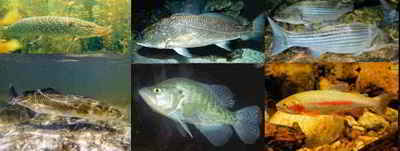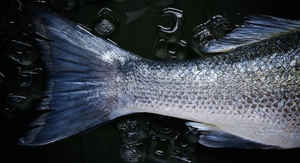New Hampshire State Saltwater Game Fish
Striped Bass

(Roccus saxatilis)
Adopted on May 6, 1994 .
The striped bass, (Roccus saxatilis,) was designated New Hampshire's official state saltwater game fish in 1994.
The striped bass is currently the most sought-after coastal sportfish species in New Hampshire.
New Hampshire Revised Statutes Annotated (RSA) 3:19
New Hampshire State Saltwater Game Fish:
Striped
Bass
 This highly migratory
fish moves north from the mid-Atlantic area during the spring and back southward during the fall, spending roughly the months of May through October
feeding on Great Bay's abundant food resources, including river herring, pollock and silversides. The Chesapeake Bay and Hudson River estuaries contain
the major spawning and nursery areas for East Coast striped bass. Spawning typically takes place during April and May in the freshwater tributaries
of these estuaries. Almost all females are mature by the time they reach 36 inches in length and 5 to 9 years in age. The striped bass has a large
mouth and sharp, stiff spines located on the gill covers, anterior dorsal fin and anal fin. A full-bodied fish, the striped bass is bluish to dark
olive dorsally, with a silvery belly and sides. Several dark, lateral stripes, reaching from the gills to the base of the tail, are the most prominent
features distinguishing the striped bass from other coastal species. Stripers caught in New Hampshire range from 10 to more than 50 inches in length,
and can weigh in excess of 50 pounds. Due to successful coastwide management implemented in 1981, striped bass catches have greatly increased in recent
years.
This highly migratory
fish moves north from the mid-Atlantic area during the spring and back southward during the fall, spending roughly the months of May through October
feeding on Great Bay's abundant food resources, including river herring, pollock and silversides. The Chesapeake Bay and Hudson River estuaries contain
the major spawning and nursery areas for East Coast striped bass. Spawning typically takes place during April and May in the freshwater tributaries
of these estuaries. Almost all females are mature by the time they reach 36 inches in length and 5 to 9 years in age. The striped bass has a large
mouth and sharp, stiff spines located on the gill covers, anterior dorsal fin and anal fin. A full-bodied fish, the striped bass is bluish to dark
olive dorsally, with a silvery belly and sides. Several dark, lateral stripes, reaching from the gills to the base of the tail, are the most prominent
features distinguishing the striped bass from other coastal species. Stripers caught in New Hampshire range from 10 to more than 50 inches in length,
and can weigh in excess of 50 pounds. Due to successful coastwide management implemented in 1981, striped bass catches have greatly increased in recent
years.
Common Names
STRIPER; ROCKFISH; ROCK; LINESIDES
Characteristics of the Striped Bass
The striped bass, (Roccus saxatilis,) is an anadromous species distributed along the Atlantic coast from northern Florida to the St. Lawrence estuary. It has been successfully introduced in numerous inland lakes and reservoirs and to the Pacific coast, where it now occurs from Ensenada, Mexico to British Columbia.
Temperate basses have two dorsal fins (the first with usually nine spines and the second with one spine), three anal spines, a large mouth, ctenoid scales, thoracic pelvic fins, a large spine on the gill cover and a small gill on the underside of the gill cover. These fishes are popular sport fishes.
Striped bass have a dark, olive-green to bluish-black back and silvery-white sides and belly. There are 7 to 8 black, unbroken, horizontal stripes along the side.
Typical Adult:
20-30 inches, 3-10 pounds. Striped bass can live in excess of 30 years under good habitat conditions and light fishing pressure. Hence they have the potential to reach 48 inches and 60 - 100 lbs or better.
Habitat:
Striped bass are an anadromous species of fish. Anadromous fish inhabits both fresh water and salt water, depending on the time of year. Striped bass live in the Atlantic and Pacific coastal waters and the Gulf of Mexico but enter freshwater streams to spawn. The preferred water temperature is 65-75°F. In South Carolina, striped bass are found in Coastal rivers and estuaries, as well as large impoundments. Adult striped bass prefer water temperatures less than 75 degrees F and will often lose weight and suffer additional health problems when forced to live under warmer conditions. Their over riding selection for temperature can isolate them from prey and acceptable levels of oxygen.
Feeding Behavior:
The diet of striped bass consists mostly of soft-rayed fish. Preferred species in fresh water are threadfin shad, gizzard shad and blueback herring. Striped bass commonly herd schools of prey fish against the surface, where their frenzied feeding can splash water several feet in the air. The heaviest feeding times are at dawn and dusk.
Reproductive Behavior (Spawning):
Prior to spawning in early spring, striped bass migrate up rivers. Spawning occurs when water temperatures reach 60-70°F. Adults swim up tributary streams and spawn below dams or natural obstructions such as rock formations. The semi-buoyant eggs are released iin light to moderate current and fertilized by several males in a thrashing event known as a "fight". As many as 3,000,000 eggs may be released by one female. The eggs require a flow adequate to prevent their settling to the bottom during the incubation period of approximately 50 hours. During their first few days of life the larval fish are sustained by a yolk material while they continue to develop until they can feed on zoo plankton. Adults do not guard the eggs.
New Hampshire Statutes
The law designating the striped bass as the official New Hampshire state saltwater game fish is Section 3:19 (State Saltwater Game Fish) of the New Hampshire Revised Statutes Title 1 (The State and Its Government) Chapter 3 (State Emblems, Flag, Etc) Section 3:19.
TITLE I
THE STATE AND ITS GOVERNMENT
CHAPTER 3
STATE EMBLEMS, FLAG, ETC.
Section 3:19
3:19 State Saltwater Game Fish. - The striped bass, Roccus saxatilis, is hereby designated as the official state saltwater game fish of New Hampshire.
Source. 1994, 79:1, eff. May 6, 1994.
Taxonomic Hierarchy: Striped Bass
Kingdom: Animalia - animals
Phylum: Chordata - chordates
Subphylum: Vertebrata - vertebrates
Superclass: Actinopterygii - ray-finned fishes
Class: Perciformes - perch-likes
Order: Moronidae --temperate basses
Family: Roccus
Genus: Roccus saxatilis








